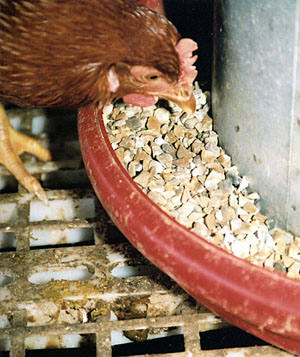
In most free range management plans grit is the vaguely worded add on. It is usually described as simply being "available" or fed "ad-lib". There are experienced egg producers who have had success with flock after flock without feeding so much as a handful of the stuff.
But the RSPCA is now to include guidance, in its latest version of the Freedom Food standards, on how much grit to feed. The current standards simply say "Hens must have access to insoluble grit (e.g. flint) no less than once weekly."
The updated version of the standards will have an information box which will explain: "The provision of insoluble grit for laying hens is considered to be very important to aid digestion and can be beneficial to young pullets as well as to laying hens. Birds should be provided with an appropriate quantity of insoluble grit from three weeks of age and throughout their lives." It gives a table of recommended amounts and sizes as follows:
Age of bird Grit size Quantity
Chicks (from 3 weeks) 0.2 mm 1g per bird (max) once a week in feed
Pullets (6-11 weeks) 3.2 - 4.75 mm 2g per bird, once a week with food
Pullets (11 weeks-p.o.l.) 4.75 - 6.35 mm 4-5g per bird once a week with food or in separate feeder
Laying hens 6.35 - 8 mm 28g per bird per month sprinkled on
food or in separate feeder
The new advice has been prepared by the FF Laying Hen Working Group which includes a BFREPA representative. David Spackman, the vet and independent poultry consultant who also sits on the committee, told the Ranger: "I am sure this is the correct advice to produce healthy layers. There are people who believe that free range birds will source enough grit from the range but this is simply not the case. Very few soils in Britain contain enough particles of the right size to supply birds with their needs. Many types of soil, like sand and clay, have none at all."
Not only is insoluble grit necessary for normal digestion and health but Mr Spackman believes it can also improve shell quality. This is not connected with extra calcium—supplied by some producers through soluble grit like marine shell—but through improved digestion and other physiological mechanisms.
Insoluble grit can also help avoid mortality caused by crop problems. "I have recently seen a flock which were given bailer twine in a bid to avoid feather pecking," said Mr Spackman, "the birds ingested some of the string causing quite a large number of losses. Feeding grit solved the problem even though we were dealing with nylon strands. I have seen the same effect where grass has been topped before pullets have been released onto range and they have eaten the hay in large quantities."
Mr Spackman feeds grit to his own birds by piling it up on the range but acknowledges that feeders may be necessary inside sheds. And he warns that it is possible to overfeed.
"Birds will take on too much grit," he says, "they then stop eating and performance falls off. When the recommended amount has been fed then the flock should be left without. If an inspector comes round at that point then the producer must explain that the birds have had their ration for that week or month."
The RSPCA say a number of producers have reported that by feeding grit during the rearing period it has overcome the problem of ’gorging’ when birds are moved to the laying house.
At 28g per bird per month a flock of 10,000 birds will consume around 3.5 tons over the laying cycle. At £160 per ton that will mean a cost of £560. Extra feeders could also add to costs.
There are no recommendations about soluble grit. "Not that I would rule it out," said Mr Spackman, "even with scientifically balanced modern diets there are times in the bird’s life where supplies of calcium can be vital as in the ten days before the onset of lay when a bird is laying down the medullary bone from which it will draw calcium to help create egg shells for the rest of its life."
But what about those producers who, for years, have never fed grit and have still had healthy flocks and good performance figures? "I know of such people," said Mr Spackman, "I have no explanation for it."
